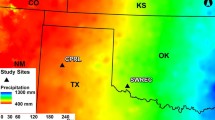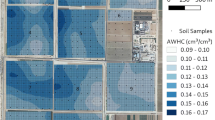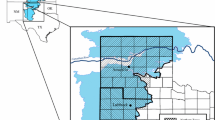Abstract
Site-specific management of cotton (Gossypium hirsutum) cropping systems at the production-scale requires information regarding environmental interactions across the landscape. Landscape-scale cotton models could track these interactions and be integrated into future decision support tools designed to manage variable inputs; however, modeling of cotton systems across the landscape has not been evaluated. Cotton production in the Southern Texas High Plains is dependent on irrigation from the Ogallala Aquifer, and thus tracking soil water content across fields could help producers plan their use of diminishing aquifer resources. Our hypothesis was that the PALMScot model, a grid-based landscape-scale cotton model, would capture spatial and temporal variability and environmental interactions affecting soil water and plant growth within a 70-ha field throughout two contrasting growing seasons, without adjustment of input parameters for the model. Thus, our objective was to compare values of soil water content and crop height calculated by the PALMScot model with corresponding field measured values at multiple locations across a fine textured, pivot irrigated production cotton field during two growing seasons. The PALMScot model calculated values of soil water and crop height across the field with a root mean squared deviation (RMSD) for soil water content in the 1.0-m profile ≤0.032 m3/m3 and most Nash–Sutcliffe efficiency (NSE) values ≥0.48. Values of RMSD for crop height were ≤0.10 m at all locations in 2010 and 2011. We conclude that PALMScot correctly and efficiently calculated soil water content and crop height across the field, throughout each season, and the model has potential as a site-specific management tool for cotton cropping systems.





Similar content being viewed by others
Notes
Mention of this or other proprietary products is for the convenience of the readers only and does not constitute endorsement or preferential treatment of these products by USDA-ARS, Texas Tech University, or the University of Wisconsin.
References
Baker, D. N., Lambert, J. R., & McKinion, J. M. (1983). GOSSYM: A simulator of cotton crop growth and yield. South Carolina Agricultural Experiment Station Bulletin (Vol. 1089). Clemson: Clemson University.
Baumhardt, R. L., Staggenborg, S. A., Gowda, P. H., Colaizzi, P. D., & Howell, T. A. (2009). Modeling irrigation management strategies to maximize cotton lint yield and water use efficiency. Agronomy Journal, 101(3), 460–468.
Bonilla, C. A., Norman, J. M., & Molling, C. C. (2007). Water erosion estimation in topographically complex landscapes: Model description and first verifications. Soil Science Society of America Journal, 71(5), 1524–1537.
Bonilla, C. A., Norman, J. M., Molling, C. C., Karthikeyan, K. G., & Miller, P. S. (2008). Testing a grid-based soil erosion model across topographically complex landscapes. Soil Science Society of America Journal, 72(6), 1745–1755.
Booker, J. D. (2013). Modeling landscape-scale water balance in irrigated cotton systems. Ph. D, Dissertation, Texas Tech University, Lubbock, TX.
Booker, J. D., Lascano, R. J., Evett, S. R., & Zartman, R. E. (2014). Evaluation of a landscape-scale approach to cotton modeling. Journal, 106(6), 2263–2279.
Booker, J. D., Lascano, R. J., & Molling, C. C. (2011). Incorporating of monitoring systems to model irrigated cotton at a landscape level. In National Cotton Council (Ed.), Beltwide Cotton Conferences Proceedings, Atlanta, GA, 2011 (pp. 1389–1396).
Bordovsky, J. P., Lyle, W. M., Lascano, R. J., & Upchurch, D. R. (1992). Cotton irrigation management with LEPA systems. Transactions of the ASAE, 35(3), 879–884.
Bronson, K. F., Booker, J. D., Officer, S. J., Lascano, R. J., Maas, S. J., Searcy, S. W., & Booker, J. (2005). Apparent electrical conductivity, soil properties and spatial covariance in the U. S. Southern High Plains. Precision Agriculture, 6(3), 297–311.
Brown, P. W. (2013). Heat Units. College of Agriculture and Life Sciences, Cooperative Extension, The University of Arizona, AZ1602.
Campbell, G. S. (1974). A simple method for determining unsaturated conductivity from moisture retention data. Soil Science, 117(6), 311–314.
Chávez, J., Pierce, F., Elliott, T., & Evans, R. (2010a). A remote irrigation monitoring and control system for continuous move systems. Part A: Description and development. Precision Agriculture, 11(1), 1–10.
Chávez, J., Pierce, F., Elliott, T., Evans, R., Kim, Y., & Iversen, W. (2010b). A remote irrigation monitoring and control system (RIMCS) for continuous move systems. Part B: Field testing and results. Precision Agriculture, 11(1), 11–26.
Clouse, R. W. (2006). Spatial application of a cotton growth model for analysis of site-specific irrigation in the Texas High Plains. Ph. D. Dissertation, Texas A&M University, College Station, TX.
Colaizzi, P. D., Gowda, P. H., Marek, T. H., & Porter, D. O. (2009). Irrigation in the Texas High Plains: A brief history and potential reductions in demand. Irrigation and Drainage, 58(3), 257–274.
Dukes, M., & Perry, C. (2006). Uniformity testing of variable-rate center pivot irrigation control systems. Precision Agriculture, 7(3), 205–218.
Ephrath, J. E., Goudriaan, J., & Marani, A. (1996). Modelling diurnal patterns of air temperature, radiation wind speed and relative humidity by equations from daily characteristics. Agricultural Systems, 51(4), 377–393.
ESRI (2013). ArcMap 10.0. ESRI, Inc.
Evett, S. R., Tolk, J. A., & Howell, T. A. (2003). A depth control stand for improved accuracy with the neutron probe. Vadose Zone Journal, 2(4), 642–649.
Evett, S. R., Tolk, J. A., & Howell, T. A. (2006). Soil profile water content determination: Sensor accuracy, axial response, calibration, temperature dependence, and precision. Vadose Zone Journal, 5(3), 894–907.
Gee, G., & Bauder, J. (1986). Particle-size analysis. In A. Klute (Ed.), Methods of soil analysis. Part 1 (2nd ed., pp. pp. 383–411, Vol. Agronomy Monograph 9). Madison, WI: ASA and SSSA.
Grimes, D., & El-Zik, K. (1990). Cotton. In B. A. Stewart, & D. R. Nielsen (Eds.), Irrigation of agricultural crops, agronomy monograph (Vol. 30, pp. 741–773), Madison, WI: ASA-CSSA-SSSA.
Hedley, C. B., & Yule, I. J. (2009a). A method for spatial prediction of daily soil water status for precise irrigation scheduling. Agricultural Water Management, 96(12), 1737–1745.
Hedley, C. B., & Yule, I. J. (2009b). Soil water status mapping and two variable-rate irrigation scenarios. Precision Agriculture, 10(4), 342–355.
Heng, L. K., Hsiao, T., Evett, S., Howell, T., & Steduto, P. (2009). Validating the FAO AquaCrop model for irrigated and water deficient field maize. Agronomy Journal, 101(3), 488–498.
Hunsaker, D. J., Clemmens, A. J., & Fangmeier, D. D. (1998). Cotton response to high frequency surface irrigation. Agricultural Water Management, 37(1), 55–74.
Kranz, W., Evans, R., Lamm, F., O’Shaughnessy, S., & Peters, R. (2012). A review of mechanical move sprinkler irrigation control and automation technologies. Applied Engineering in Agriculture, 28(3), 389–397.
Lascano, R. J. (2000). A general system to measure and calculate daily crop water use. Agronomy Journal, 92(5), 821–832.
Lascano, R. J., & Booker, J. D. (2013). Precision agriculture: Water and nutrient management. In S. E. Jørgensen (Ed.), Encyclopedia of Environmental Management (1st ed., Vol. III, pp. 2217–2223): Taylor & Francis.
Lepore, B. J., Morgan, C. L. S., Norman, J. M., & Molling, C. C. (2009). A mesopore and matrix infiltration model based on soil structure. Geoderma, 152(3), 301–313.
Marani, A. (2004a). Cotton2 K help system for advanced users; Cotton2K version 4.0. Robert H. Smith Inst. of Plant Sciences and Genetics in Agriculture, Hebrew Univ. of Jerusalem. http://departments.agri.huji.ac.il/fieldcrops/cotton/.
Marani, A. (2004b). Cotton2 K model version 4.0. Robert H. Smith Inst. of Plant Sciences and Genetics in Agriculture, Hebrew Univ. of Jerusalem. http://departments.agri.huji.ac.il/fieldcrops/cotton/.
Marani, A. (2004c). Cotton2K model version 4.0: Version history. Retrieved 18 February 2013 from http://departments.agri.huji.ac.il/plantscience/cotton/Cotton2KModelDoc.htm.
Mauget, S., & Leiker, G. (2010). The Ogallala agro-climate tool. Computers and Electronics in Agriculture, 74(1), 155–162.
McBratney, A., Whelan, B., Ancev, T., & Bouma, J. (2005). Future directions of precision agriculture. Precision Agriculture, 6(1), 7–23.
McCarthy, A. C., Hancock, N. H., & Raine, S. R. (2010). VARIwise: A general-purpose adaptive control simulation framework for spatially and temporally varied irrigation at sub-field scale. Computers and Electronics in Agriculture, 70(1), 117–128.
McCarthy, A. C., Hancock, N. H., & Raine, S. R. (2013). Advanced process control of irrigation: The current state and an analysis to aid future development. Irrigation Science, 31(3), 183–192.
McCauley, J. D. (1999). Simulation of cotton production for precision farming. Precision Agriculture, 1(1), 81–94.
Molling, C. C. (2007). PALMS utilities (arca2nc, arca2soiltex, convertsoiltex, sis2soiltex, vwcinit). University of Wisconsin Board of Reagents.
Molling, C. C., Strikwerda, J. C., Norman, J. M., Rodgers, C. A., Wayne, R., Morgan, C. L. S., et al. (2005). Distributed runoff formulation designed for a precision agricultural landscape modeling system. Journal of the American Water Resources Association, 41(6), 1289–1313.
Morgan, C. L. S. (2003). Quantifying soil morphological properties for landscape management applications. Ph. D. Dissertation, University of Wisconsin-Madison.
Morgan, C., Norman, J., Molling, C., McSweeney, K., & Lowery, B. (2003). Evaluating soil data from several sources using a landscape model. In Y. A. Pachepsky, D. E. Radcliffe, & H. M. Salim (Eds.), Scaling Methods in Soil Physics (1st ed., pp. 243–260). Boca Raton, FL: CRC Press.
Moriasi, D. N., Arnold, J. G., Van Liew, M. W., Bingner, R. L., Harmel, R. D., & Veith, T. L. (2007). Model evaluation guidelines for systematic quantification of accuracy in watershed simulations. American Society of Agricultural and Biological Engineers, 50(3), 885–900.
Morrow, M. R., & Krieg, D. R. (1990). Cotton management strategies for a short growing season environment: Water-nitrogen considerations. Agronomy Journal, 82(1), 52–56.
Nair, S., Maas, S., Wang, C., & Mauget, S. (2013). Optimal field partitioning for center-pivot-irrigated cotton in the Texas High Plains. Agronomy Journal, 105(1), 124–133.
Nash, J. E., & Sutcliffe, J. V. (1970). River flow forecasting through conceptual models Part I—A discussion of principles. Journal of Hydrology, 10(3), 282–290.
National Weather Service (2013a). Lubbock precipitation: From 1911–present. Retrieved 7 May 2013 from http://www.srh.noaa.gov/lub/?n=climate-klbb-pcpn.
National Weather Service (2013b). Number of days per year with temperatures 100 degrees or above at Lubbock since 1914. Retrieved 7 May 2013 from http://www.srh.noaa.gov/lub/?n=climate-klbb-days-temp-100plus.
Nelson, J. R., Lascano, R. J., Booker, J. D., Zartman, R. E., & Goebel, T. S. (2013). Evaluation of the precision agricultural landscape modeling system (PALMS) in the semiarid Texas Southern High Plains. Open Journal of Soil Science, 3(4), 169–181.
O’Shaughnessy, S. A., & Evett, S. R. (2010). Canopy temperature based system effectively schedules and controls center pivot irrigation of cotton. Agricultural Water Management, 97(9), 1310–1316.
O’Shaughnessy, S. A., Evett, S. R., Colaizzi, P. D., & Howell, T. A. (2011). Using radiation thermography and thermometry to evaluate crop water stress in soybean and cotton. Agricultural Water Management, 98(10), 1523–1535.
Osterkamp, W. R., & Wood, W. W. (1987). Playa-lake basins on the Southern High Plains of Texas and New Mexico: Part I. Hydrologic, geomorphic, and geologic evidence for their development. Geological Society of America Bulletin, 99(2), 215–223.
Peng, S., Krieg, D. R., & Hicks, S. K. (1989). Cotton lint yield response to accumulated heat units and soil water supply. Field Crops Research, 19(4), 253–262.
Pierce, D. W. (2009). Ncview. http://meteora.ucsd.edu:80/~pierce/ncview_home_page.html.
Ping, J. L., Green, C. J., Bronson, K. F., Zartman, R. E., & Dobermann, A. (2004a). Identification of relationships between cotton yield, quality, and soil properties. Agronomy Journal, 96(6), 1588–1597.
Ping, J. L., Green, C. J., Zartman, R. E., & Bronson, K. F. (2004b). Exploring spatial dependence of cotton yield using global and local autocorrelation statistics. Field Crops Research, 89(2–3), 219–236.
Ping, J. L., Green, C. J., Zartman, R. E., Bronson, K. F., & Morris, T. F. (2007). Spatial variability of soil properties, cotton yield, and quality in a production field. Communications in Soil Science and Plant Analysis, 39(1–2), 1–16.
Radin, J. W., Mauney, J. R., & Kerridge, P. C. (1989). Water uptake by cotton roots during fruit filling in relation to irrigation frequency. Crop Science, 29(4), 1000–1005.
Radin, J. W., Reaves, L. L., Mauney, J. R., & French, O. F. (1992). Yield enhancement in cotton by frequent irrigations during fruiting. Agronomy Journal, 84(4), 551–557.
Rawls, W. J., Brakensiek, D. L., & Saxton, K. E. (1982). Estimation of soil water properties. Transactions of the ASAE, 25(5), 1316–1320.
Sadler, E. J., Evans, R. G., Stone, K. C., & Camp, C. R. (2005). Opportunities for conservation with precision irrigation. Journal of Soil and Water Conservation, 60(6), 371–378.
Schaap, M. G., Leij, F. J., & Van Genuchten, M. T. (2001). ROSETTA: A computer program for estimating soil hydraulic parameters with hierarchical pedotransfer functions. Journal of Hydrology, 251(3–4), 163–176.
Soil Survey Staff (2010). Designations for horizons and layers. In USDA-NRCS (Ed.), Keys to Soil Taxonomy (11th ed., pp. 635–647). Blacksburg, VA: Pocahontas Press.
Staggenborg, S. A., Lascano, R. J., & Krieg, D. R. (1996). Determining cotton water use in a semiarid climate with the GOSSYM cotton simulation model. Agronomy Journal, 88(5), 740–745.
Thorp, K. R., Ale, S., Bange, M. P., Barnes, E. M., Hoogenboom, G., Lascano, R. J., et al. (2014). Development and application of process-based simulation models for cotton production: A review of past, present, and future directions. Journal of Cotton Science, 18(1), 10–47.
Tolk, J. A., & Howell, T. A. (2010). Cotton water use and lint yield in four Great Plains soils. Agronomy Journal, 102(3), 904–910.
Tolk, J. A., Howell, T. A., & Evett, S. R. (1998). Evapotranspiration and yield of corn grown on three high plains soils. Agronomy Journal, 90(4), 447–454.
U. S. Department of Agriculture-Natural Resources Conservation Service (2013). Geospatial Data Gateway. Retrieved 25 March 2013 from http://datagateway.nrcs.usda.gov/.
Unger, P. W., & Pringle, F. B. (1981). Pullman soils: Distribution, importance, variability, and management. Bulletin B Vol. 1372. College Station, TX: Texas Agricultural Experiment Station.
Unidata (2013). netCDF. http://www.unidata.ucar.edu/software/netcdf/. Retrieved 19 Mar 2013.
Van Genuchten, M. T. (1980). A closed-form equation for predicting the hydraulic conductivity of unsaturated soils. Soil Science Society of America Journal, 44(5), 892–898.
Vellidis, G., Tucker, M., Perry, C., Kvien, C., & Bednarz, C. (2008). A real-time wireless smart sensor array for scheduling irrigation. Computers and Electronics in Agriculture, 61(1), 44–50.
Wang, C., & Nair, S. (2012). The economics of deficit irrigation. Natural Resource Modeling,. doi:10.1111/nrm.12004.
Wanjura, D. F., Upchurch, D. R., Mahan, J. R., & Burke, J. J. (2002). Cotton yield and applied water relationships under drip irrigation. Agricultural Water Management, 55(3), 217–237.
Web Soil Survey (2013). U. S. Department of Agriculture-Natural Resources Conservation Service. Retrieved 26 Mar 2013 from http://websoilsurvey.nrcs.usda.gov/.
Zartman, R. E., Evans, P. W., & Ramsey, R. H. (1994). Playa lakes on the Southern High Plains in Texas: Reevaluating infiltration. Journal of Soil and Water Conservation, 49(3), 299–301.
Acknowledgments
This research was supported in part by the Ogallala Aquifer Program, a consortium between USDA–Agricultural Research Service, Kansas State University, Texas A&M AgriLife Research, Texas A&M AgriLife Extension Service, Texas Tech University, and West Texas A&M University.
Disclaimer
Mention of trade names or commercial products is solely for the purpose of providing specific information and does not imply recommendation or endorsement by U. S. Department of Agriculture, Texas Tech University or University of Wisconsin. USDA, Texas Tech University and University of Wisconsin are an equal opportunity provider and employer.
Author information
Authors and Affiliations
Corresponding author
Rights and permissions
About this article
Cite this article
Booker, J.D., Lascano, R.J., Molling, C.C. et al. Temporal and spatial simulation of production-scale irrigated cotton systems. Precision Agric 16, 630–653 (2015). https://doi.org/10.1007/s11119-015-9397-6
Published:
Issue Date:
DOI: https://doi.org/10.1007/s11119-015-9397-6




